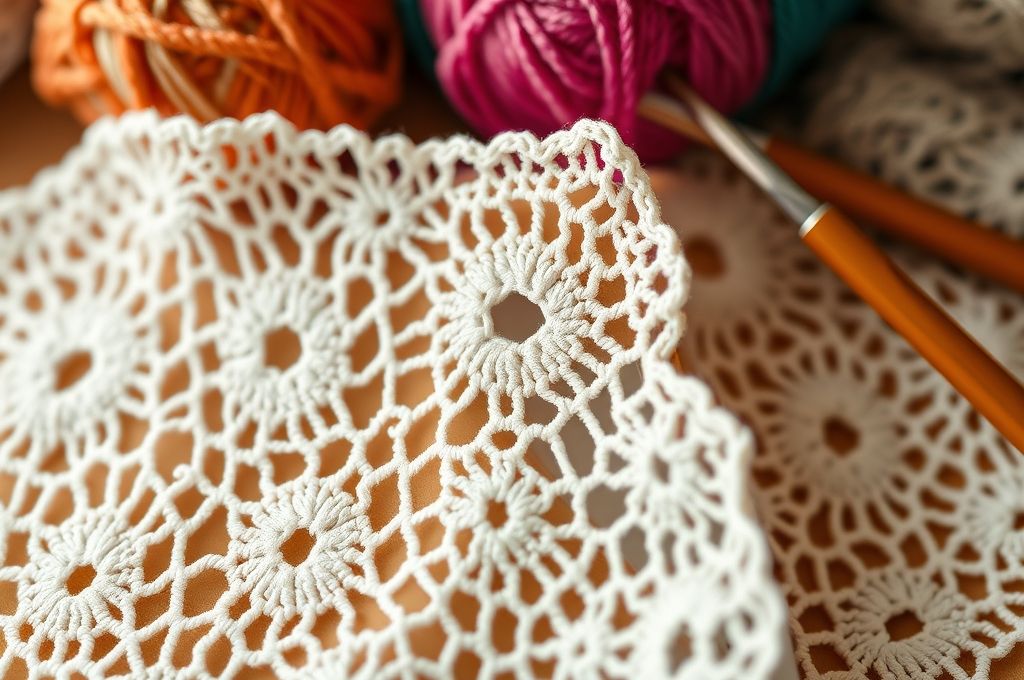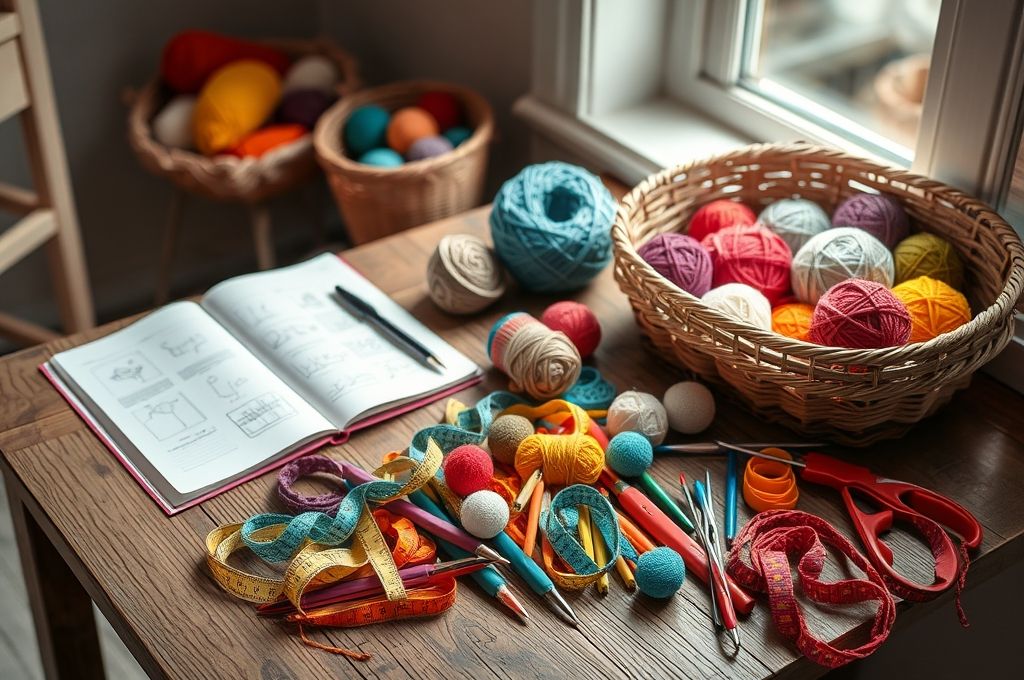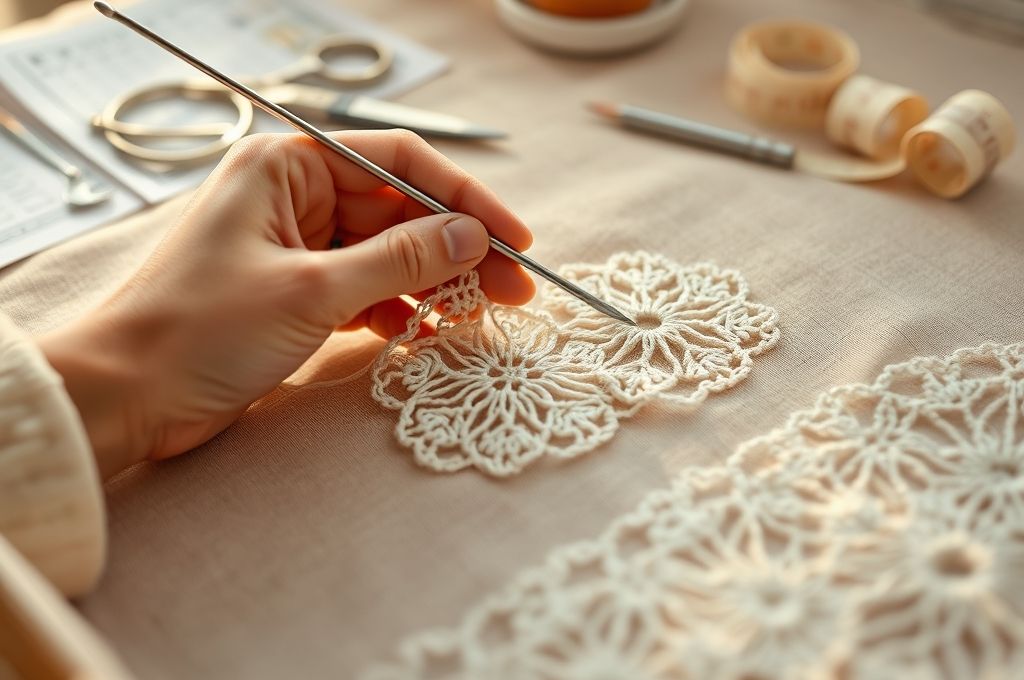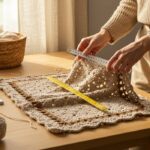The Art of Creating with Thread and Vision
Have you ever looked at a delicate lace curtain, a vintage table runner, or an intricate doily and wondered how such beauty could be made from just a hook and thread? If so, you’re not alone—and you might already be on the path to discovering filet crochet, one of the most elegant and expressive forms of textile art.
Filet crochet is more than just a crafting technique—it’s a language of open and filled spaces, a dance between negative and positive design. Born in 16th-century Europe and popularized in the 19th century, this art form uses a grid-based system to create stunning geometric and pictorial patterns. But here’s the exciting part: you don’t need to follow pre-made patterns forever. With a little know-how, you can chart your own designs and turn your imagination into tangible, handcrafted masterpieces.
In this article, we’ll dive deep into the world of filet crochet, exploring its history, structure, and creative potential. You’ll learn how to read and interpret filet charts, design your own patterns from scratch, and bring personal meaning to every stitch. Whether you’re a seasoned crocheter or just starting out, this guide will empower you to go beyond the basics and make something truly yours.
So grab your hook, a skein of cotton thread, and let’s begin turning blank grids into breathtaking works of art.
What Is Filet Crochet? Understanding the Basics

At its core, filet crochet is built on a simple yet powerful concept: a grid made of mesh blocks. Each block is either filled (solid) or open (empty), and when arranged in a pattern, these blocks form images, shapes, or decorative motifs.
The foundation of filet crochet lies in two basic stitches: the double crochet (dc) and the chain (ch). These are used to create the mesh structure—typically a 3-chain space surrounded by double crochets on either side. A filled block is usually made with three double crochets, while an open block consists of a chain space flanked by double crochets.
Quick Example:
- Open block: dc, ch 3, dc
- Filled block: dc, dc, dc
This repetitive structure makes filet crochet surprisingly easy to learn, even for beginners. What sets it apart from other crochet styles is its graph-like nature—patterns are often presented as charts, much like cross-stitch or pixel art. This visual format allows crafters to see exactly how their design will unfold row by row.
Filet crochet is traditionally worked in cotton thread, which gives it a crisp, clean finish perfect for heirloom pieces. Common projects include doilies, table linens, curtains, and decorative panels. But modern makers are pushing boundaries—using filet techniques to create wall art, fashion accessories, and even wearable garments.
Why does this matter? Because once you understand the grid system, you’re no longer limited to following someone else’s vision. You can start creating your own.
The Power of Charts: How Filet Transforms Ideas into Stitches
If filet crochet were a language, its alphabet would be the chart. Unlike written patterns that describe each row in text, filet designs are best communicated visually. A chart is essentially a pixelated blueprint where each square represents one mesh block.
Reading a filet chart is intuitive:
- Filled squares = solid blocks (3 dc)
- Empty squares = open blocks (ch-3 space)
- Rows are worked from bottom to top, and alternate between right-to-left and left-to-right (like most crochet).
But here’s where it gets exciting: you can draw your own chart.
Imagine sketching a heart, a bird in flight, or even your pet’s silhouette—and then turning that drawing into a step-by-step crochet guide. That’s the magic of filet. It bridges the gap between drawing and crafting, making it accessible to anyone who can use graph paper or digital tools.
For example, let’s say you want to create a simple star. On a 10×10 grid, you’d shade in the squares that form the star’s shape. Then, you’d translate each row into crochet instructions. The result? A handmade decoration infused with personal meaning.
Pro Tip: Start small. Try converting a 5-letter word into a filet chart using block letters. Each letter becomes a vertical column of filled and open blocks—perfect for a personalized bookmark or wall hanging.
By mastering charts, you shift from being a follower of patterns to a creator of them. And that’s where the real joy begins.
Designing Your First Filet Pattern: From Sketch to Stitch
Ready to make your own design? Let’s walk through the process step by step. You don’t need fancy software or artistic training—just a clear idea and a willingness to experiment.
Step 1: Choose Your Subject
Start simple. Think of something meaningful: a name, a symbol, a seasonal motif like a snowflake or flower. The key is clarity—avoid overly detailed images at first.
Step 2: Use Graph Paper or Digital Tools
Grab a sheet of graph paper (or use free tools like Excel, KnitPro, or Stitch Fiddle). Each square equals one mesh block. Draw your design by filling in the squares.
Remember: Most filet patterns use a 2:1 ratio—two rows of mesh for every one row of design. This means your image will be built across multiple rows, often with a border of open mesh around it.
Step 3: Add Borders (Optional but Recommended)
Traditional filet pieces often include a border made of alternating open and filled blocks. This frames the design and gives it structure. A common border is 3–5 rows of mesh around the entire piece.
Step 4: Translate to Crochet
Now, go row by row. For each row, count the blocks and write down whether they’re open or filled. Then convert that into stitch instructions.
For instance:
- Row 1: Open, Open, Filled, Filled, Open → dc, ch 3, dc, ch 3, dc, dc, dc, dc, dc, ch 3, dc
Repeat this for every row, and you’ve got your custom pattern!
Step 5: Test It
Crochet a small swatch to see how your design looks in real life. You might need to adjust spacing or scale—this is all part of the creative process.
Creating your own filet design isn’t just about technique—it’s about self-expression. Every stitch carries intention. Whether it’s a gift for a loved one or a piece for your home, your design tells a story only you can tell.
Tools and Materials: Setting Up Your Creative Space

Before you dive into designing, make sure you have the right tools. Just like a painter needs brushes and canvas, a filet crocheter needs the proper materials to bring their vision to life.
Yarn or Thread
Filet crochet traditionally uses size 10 or 20 cotton thread, known for its strength and sheen. Brands like Aunt Lydia’s, DMC, and Lily Sugar’n Cream offer excellent options. Cotton holds its shape well, which is crucial for maintaining the crisp lines of filet mesh.
If you’re experimenting, you can also use lightweight yarn (like fingering or sport weight), but keep in mind that the open spaces may stretch more.
Hook Size
Match your hook to your thread. For size 10 cotton, a steel hook size 7 (1.65mm) works well. Always do a gauge swatch—if your mesh squares aren’t uniform, adjust your hook size accordingly.
Graph Paper and Design Tools
While pencil and paper are perfectly fine, digital tools can speed up the process:
- Stitch Fiddle (free online): Great for designing and sharing charts.
- Excel or Google Sheets: Use cell borders to create a grid; color cells with fill tools.
- Cross-stitch apps: Many can be adapted for filet since they use the same grid logic.
Other Helpful Supplies
- Tapestry needle (for weaving in ends)
- Scissors
- Stitch markers (to mark pattern repeats)
- Clipboard or lightbox (to hold your chart while crocheting)
Having a dedicated, organized space makes designing and crocheting more enjoyable. Keep your tools within reach, your chart visible, and your inspiration close.
Fun Fact: Many vintage filet patterns were shared in women’s magazines in the early 1900s. Today, we have online communities like Ravelry and Instagram where makers share original charts daily—proof that this art form is very much alive.
Common Challenges—and How to Overcome Them
Even with a solid plan, filet crochet can come with hiccups. The good news? Most issues are easy to fix once you know what to look for.
Miscounting Blocks
One missed stitch can throw off an entire row. To avoid this:
- Use a row counter to track your progress.
- Mark completed rows with a sticky note or highlighter on your chart.
- Count blocks before you start each row.
Uneven Tension
If your mesh spaces are too tight or too loose, your design will look distorted. Practice consistent tension by:
- Holding your thread the same way each time.
- Relaxing your grip on the hook.
- Blocking your finished piece (wet and pin it to shape).
Designs That Don’t Translate Well
Not every image works in filet. Fine details, curves, or gradients can get lost in the blocky grid. To improve clarity:
- Simplify your design. Think “pixel art.”
- Use bold outlines.
- Stick to high-contrast shapes (e.g., a black cat against a white sky).
Losing Motivation
Big projects can feel overwhelming. Break them into smaller goals:
- Finish one row per day.
- Reward yourself after completing a section.
- Share progress photos with friends or online groups.
Story Time: One crafter wanted to make a filet portrait of her grandmother. After several failed attempts, she realized the photo had too much detail. She switched to a simple outline of her grandmother’s profile—set against a sunburst background. The result was stunning, emotional, and far more effective than a realistic attempt.
Remember: every expert was once a beginner. Mistakes aren’t failures—they’re part of the learning process.
Beyond the Doily: Modern Applications of Filet Crochet
Let’s be honest—when many people hear “filet crochet,” they picture doilies on sofa arms or lace curtains in grandma’s house. But this art form has evolved far beyond traditional uses.
Today’s makers are using filet crochet in bold, innovative ways:
Wall Art and Home Decor
Large-scale filet panels can become striking wall hangings. Imagine a geometric mandala, a quote in cursive, or a city skyline—all made in cotton thread. These pieces add texture and warmth to modern interiors.
Fashion and Accessories
Designers are incorporating filet into garments:
- Sleeves with floral filet patterns
- Bags with nautical-themed mesh panels
- Shawls that blend filet with colorwork
The breathable nature of the mesh makes it ideal for summer wear.
Personalized Gifts
A filet coaster with a couple’s initials, a baby blanket with a teddy bear motif, or a holiday ornament with a snowman—these are keepsakes people treasure for years.
Community and Activism
Some artists use filet to make political or social statements. A crocheted protest sign in mesh, a rainbow pride flag, or a climate change message—all possible with filet charts.
Real-Life Example: A group in France created a massive filet installation spelling “ESPERANCE” (Hope) during a pandemic, hanging it across a city square. It became a symbol of resilience.
Filet crochet isn’t stuck in the past. It’s a living, evolving craft that adapts to our times, our stories, and our needs.
Inspiration from the Masters: Learning from Vintage and Contemporary Designers
One of the best ways to grow as a designer is to study the work of others. Throughout history, filet crochet has been shaped by anonymous artisans, magazine editors, and today’s digital creators.
Vintage Patterns (1800s–1950s)
Old needlework books are treasure troves of elegant designs:
- Floral sprays
- Monograms
- Religious symbols
- Nature scenes (birds, trees, butterflies)
These patterns often feature symmetry and balance, teaching us how to compose a visually pleasing layout. Even if you don’t copy them directly, studying their structure can improve your own designs.
Mid-Century Modern Influence
In the 1950s and 60s, filet took on a more geometric, abstract style. Think zigzags, chevrons, and atomic-age motifs. This era shows how filet can reflect cultural trends.
Today’s Innovators
Browse platforms like Etsy, Instagram, or Ravelry to see how modern crocheters are pushing boundaries:
- @filetartist creates hyper-detailed animal portraits.
- Crochet Converse offers free filet tutorials and charts.
- Lion Brand Yarn publishes contemporary filet patterns for home decor.
Try This: Pick a vintage pattern and “remix” it. Add a modern twist—change the border, flip the orientation, or combine two designs into one.
By learning from the past and present, you build a richer creative vocabulary.
From Hobby to Healing: The Emotional Rewards of Creative Design
Let’s talk about something deeper than stitches and charts: the emotional impact of creating.
In a world full of screens, noise, and constant demands, filet crochet offers a rare gift—mindful creativity. When you chart your own design, you’re not just making something beautiful; you’re engaging in a form of self-care.
It Slows You Down
Each row requires focus. You count, stitch, and watch the pattern emerge. This rhythm can be meditative, helping reduce stress and anxiety.
It Builds Confidence
Completing a self-designed piece is empowering. You thought it up, planned it, and brought it to life. That sense of accomplishment strengthens self-trust.
It Connects You to Others
Share your design with a friend. Teach someone how to read a chart. Gift a handmade piece with a story behind it. These acts deepen relationships.
It Leaves a Legacy
Unlike digital files that can vanish, a hand-crocheted piece can last generations. Your filet design might one day be passed down, admired, and cherished.
A Moment to Reflect: What would you create if you knew no one would judge it? A child’s name? A symbol of hope? A memory of a lost loved one? Your answer might be the seed of your next masterpiece.
Creativity isn’t a luxury—it’s a human need. And filet crochet, with its blend of structure and freedom, is a perfect outlet.
Bringing It All Together: Your Journey as a Filet Designer
We’ve covered a lot: the basics of filet crochet, how to read and create charts, the tools you need, common challenges, modern applications, and even the emotional power of making.
But here’s the truth: no amount of reading can replace the act of doing.
You don’t need to be perfect. You don’t need expensive supplies. You just need to start.
Begin with a tiny design—a heart, a star, your initial. Sketch it on graph paper. Crochet one row. Then another. Watch as your idea takes shape, thread by thread.
Over time, you’ll develop your own style. Maybe you’ll love intricate pictorial work. Maybe you’ll prefer bold geometric patterns. Or perhaps you’ll invent something entirely new.
And when someone asks, “Where did you get that pattern?” you’ll smile and say, “I made it myself.”
That’s the beauty of filet crochet: it’s not just about following instructions. It’s about charting your own path—literally and figuratively.
Conclusion: Create, Stitch, Inspire
Filet crochet is more than a craft—it’s a creative journey. From its historical roots to its modern reinvention, it offers a unique blend of structure and freedom. By learning to chart your own designs, you unlock a world of personal expression, mindfulness, and connection.
We’ve explored how to turn simple grids into meaningful art, how to choose the right materials, and how to overcome common challenges. We’ve seen how filet can decorate homes, inspire communities, and heal hearts.
Now, it’s your turn.
Pick up your hook. Sketch a small idea. Make your first stitch. Don’t worry about perfection—focus on progress.
And when you finish your piece, take a moment to appreciate what you’ve done. You didn’t just follow a pattern. You created something original. Something handmade. Something yours.
If you’ve enjoyed this journey, I’d love to hear from you. Share your first filet design in the comments, tag me on social media, or simply pass this article along to someone who might need a little creative spark.
Because in the end, every stitch tells a story. What will yours say?

Daniele Ferreira is passionate about the world of crochet, dedicating her time to exploring techniques, creating unique pieces, and sharing her knowledge with beginners and aficionados alike. With attention to detail and creativity, she transforms yarn into true works of art, inspiring others to discover the beauty and joy of this manual art.







